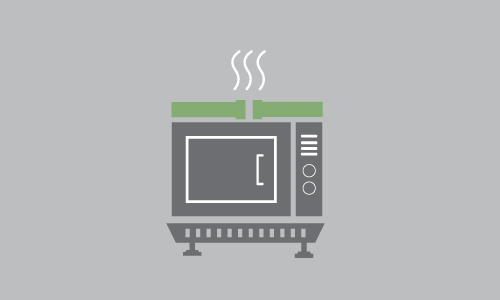Process heating is a science, and the application of heat is a necessary part of the manufacturing world. From drying paint to cooking food, ovens, dryers, and other custom machinery are a necessity for manufacturers. Knowing this, during the decision and selection process, you will need to make a few decisions on the way you need your product to work—one of the most important of these being heat source. Today, we would like to explore the rise of infrared heating technology and discuss how it can benefit a wide range of manufacturers.
Infrared Heat for Industrial Applications
Infrared is a form of electromagnetic wave or radiation which lies just between visible light and microwaves/radio waves. The existence of infrared waves was discovered in 1800, but in recent decades, manufacturers in a wide range of industries have embraced the use of infrared heating for a wide range of applications. Before we can discuss the basics or benefits of infrared heat, we first have to step back to the three ways heat is transferred—conduction, convection, and radiation.
Three Methods of Heat Transfer: Convection, Conduction, and Radiation
Heat transfer is the physical act of thermal energy being exchanged between two systems by dissipating heat. Dictated by temperature and flow of heat, heat transfer takes place through one of three forms—conduction, convection, and radiation. Machine Design Magazine provides a full look at the science behind each of these three heat transfer methods, summarized below.
Conduction
Occurring through contact, conduction is the transfer of energy from an area with greater kinetic energy to an area with lower kinetic energy. Temperature flow will always occur from hottest to coldest or, as stated before, higher to lower kinetic energy. Once there’s thermal equilibrium between the two temperature differences, the thermal transfer stops.
While this is the most commonly understood method of heat transfer (i.e. if you touch something hot), it’s rarely part of the manufacturing process as direct contact between heat source and product is not possible or plausible.
Convection
When a fluid, such as air or a liquid, is heated and then travels away from the source, it carries the thermal energy. This type of heat transfer is called convection. The fluid above a hot surface expands, becomes less dense, and rises.
Still very common in the manufacturing industry, convection is practical for some applications, but impractical for others—especially when airflow is undesirable.
Radiation
The final type of heat transfer is thermal radiation. Thermal radiation generates from the emission of electromagnetic waves. These waves carry the energy away from the emitting object. All materials radiate thermal energy based on their temperature. The hotter an object, the more it will radiate.
As temperature increases, the wavelengths within the spectra of the emitted radiation decrease and emit shorter wavelengths with higher-frequency radiation. Infrared process heating is included under this type of heat transfer method, and has become both popular and effective among manufacturers who need controlled heat without the use of convection.
How Infrared Process Heating Works
Whether used for preheating, heating, finishing, or postheating infrared heating can be used for a wide variety of applications. A form of thermal radiation, heat is transferred from the source to the target using invisible electromagnetic energy. When this energy reaches the surface of the target, it causes molecules to vibrate rapidly and generate heat energy. Heat energy then penetrates the product via conduction.
This targeted “flash” of heat is ideal for manufacturers who need uniformity or minimal heat penetration. Operating efficiently, infrared systems are able to work within a very limited temperature range (+/- 1°C) and deliver consistency for manufacturers.
Whether this application is drying or curing paint, powder coatings, ink, or adhesives; heat setting for textiles manufacturing; or delivering food-safe heating for food manufacturers ranging from pre-melting cheese on pizzas to toasting chips to browning meat.
Custom Manufacturing Equipment and Process Heating Solutions from The CMM Group
Whatever your specific curing, baking or drying application might be, you can rely on The CMM Group to deliver a custom process heating solution that can meet and exceed the needs of your plant. The CMM Group has completed projects for global, national, regional, and local manufacturers and can provide solutions for multiple points of the manufacturing process—from preheating to pollution control.
In the market for a new oven or dryer? We invite you to read our free oven and dryer selection and installation guide to understand your options and the buying process. Get to know more about our work here and contact us for more information!




